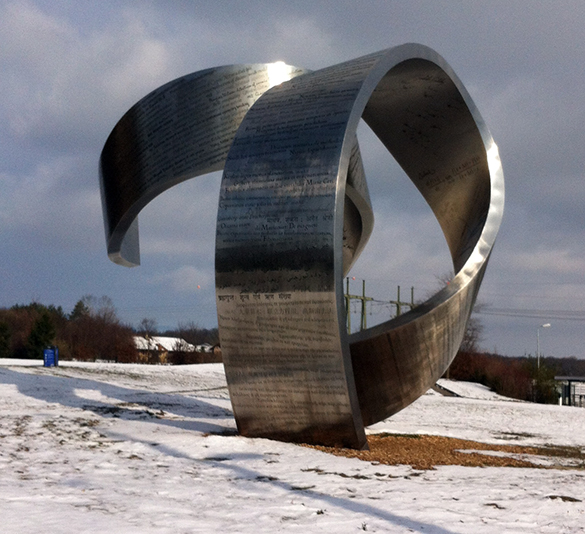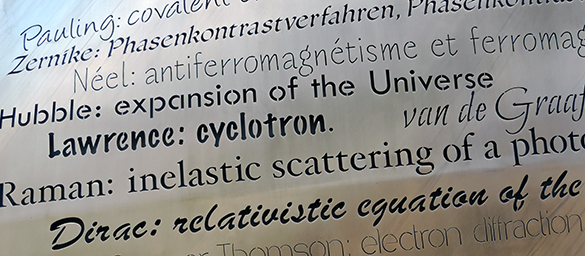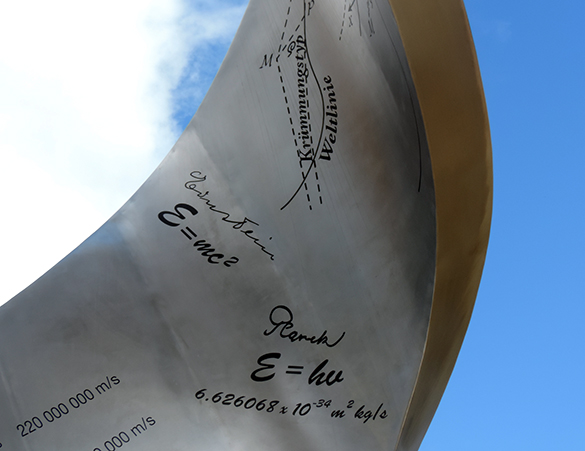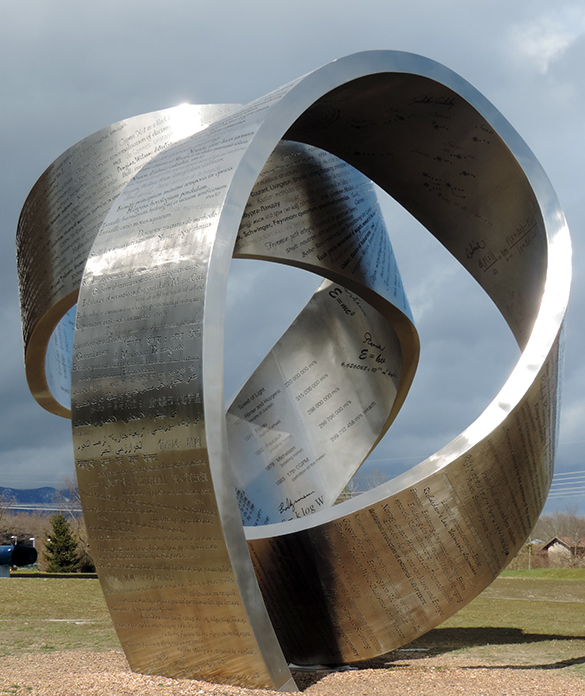It is January. I am on a tram at the border of France and Switzerland just by CERN, the European Organization for Nuclear Research, (the Large Hadron Collider guys.) I notice a huge curling metal structure standing proud from the persistent snow. A biting wind dissuades interest beyond a long-distance snap with my iPhone.
On-line, I find that this work is “Wandering the Immeasurable” by Gayle Hermick. I speak to a physicist friend who works at CERN. “All of us love that sculpture!” he explains. “It tells the entire story of our field.” I am intrigued. This reminds me of a stroll through Cambridge (UK,) and how beautiful sculptures and paintings are used to pay tribute to the brilliant minds who have brought extraordinary advances in knowledge and ultimately changed humanity.
More snow. The weeks pass before I want to return. When I do, I find this to be a work of staggering beauty in which the aesthetic combines with what is probably the most important human narrative of all.
Hermick visited the CERN site in 2005. She was bowled over by the enormity of what the Large Hadron Collider represents: a massively ambitious experiment based on centuries of scientific exploration. What inspired her was the realization that any theory in physics is based on theories that came before it that, in turn, are based on other precedents. The connections between theories weave together the story of science. One side of the coiling stainless steel ribbon carries 396 important scientific and technical discoveries inscribed in their language of origin, accompanied by the names of their discoverers. The list begins with sexagesimal calculations in Mesopotamia from 4000 years ago and ends – for the time being – with the discovery of the Higgs boson at CERN. The tail of the ribbon remains suspended, as if awaiting future events.
The other side of the ribbon showcases mathematics: the language of science. This helps the visitor, whatever his or her background, to appreciate how mathematics underpins the 396 discoveries. The whole is accessible to the non-scientist and so resonates with the educational goals of CERN.
Putting the aesthetic and the narrative aside; the work is awe-inspiring as a technical accomplishment. It took a crew of metal workers over a year to make. The process involved specialists who could laser-cut the text and electro-plate the equations into stainless steel.
And what of the “who” behind this monumental work? Gayle Hermick trained in Fine Arts at the University of Manitoba, Canada. She gravitated to sculptural forms in clay. Metal was a natural evolution. She is tolerant of my persistence and generous with her time giving honest and elegant answers to my questions. I ask her how she won the commission for the work. She replies “It wasn’t a commission. I pitched the idea for a sculpture on the site after touring the then ‘in progress’ Large Hadron Collider. I did not visit CERN with a physics or mathematics background. The dance to create the right sculpture involved much research on my part and some to and fro with CERN to gain more insight into particle physics. I realized quickly that I did not have enough knowledge about contemporary physics to create a work about a specific theory but I also realized that I was in good company with most of the world. My sculpture grew naturally from this point. I wanted it to be both a monument to what has been achieved and to inform myself, and hopefully others, about how we, humanity, got to the point of colliding particles just under the speed of light to understand what makes up our universe.” (Wow!) She continues “I was enthralled with the beautiful but impenetrable equations accompanying every article I researched.”
She tells me that whilst the inspiration for “Wandering the Immeasurable” was sparked by her 2005 visit to CERN, the visual concept came from the multicultural nature of CERN as an institution, its scientific goals, its educational goals and, by her own admission, her ignorance and confusion about contemporary physicists and theories. I cannot imagine that there exists many other sculptors with intellectual horizons as broad.
Naively, I ask her if, as a result of her extensive research, she has a favourite physicist or theorem. “This (the whole project) has been an exhilarating plunge into the history of science and physicists that will stay with me the rest of my life. I admire greatly the early scientists who came to their discoveries from different disciplines, there are so many – one, Gilbert, a physician, arrived at the conclusion the earth was magnetic which is why the compass points north. And there’s the ingenuity of Pascal’s calculating machine. Galileo’s dedication to observation is breathtaking; his thorough documentation of the moons of Jupiter and sun spots are astounding feats. I read about the careful tabulation of astronomical data from Brahe enabling Kepler to discover his laws of planetary motion. I enjoyed biographies of physicists: the Curies, Rutherford, Heisenberg, Planck, Bohr, and Dirac to name a few. And what an exciting time in physics just prior to World War II! After years of quiet experimentation, I believe (with discovery of the Higgs boson and the potential output from the Large Hadron Collider), we are in another exciting time for both cosmology and particle physics.” Does she understands physics now? “Robin I think this question is very funny!” she answers. “I think there are physicists who don’t understand contemporary physics.” She then lists, with citations, some prominent physicists who admit to not fully comprehending their chosen field. The list includes Einstein who, apparently, did not believe in quantum theory.
So, as the warmer weather approaches, why not visit CERN and Hermick’s stunning creation? Take a picnic, listen to music, take photos and consider…. but for those texts and equations, you wouldn’t have got there, you would have no leisure time because you would be so busy trying to find enough food for your picnic, there would be no way that music could be recorded and you wouldn’t be able to take photos because cameras wouldn’t exist. In brief, without those scientists and their discoveries, all of our lives, assuming we even existed, would be solitary, poor, nasty, brutish, and short.





Really nice and captures pretty nicely why art and science are so closely linked 🙂